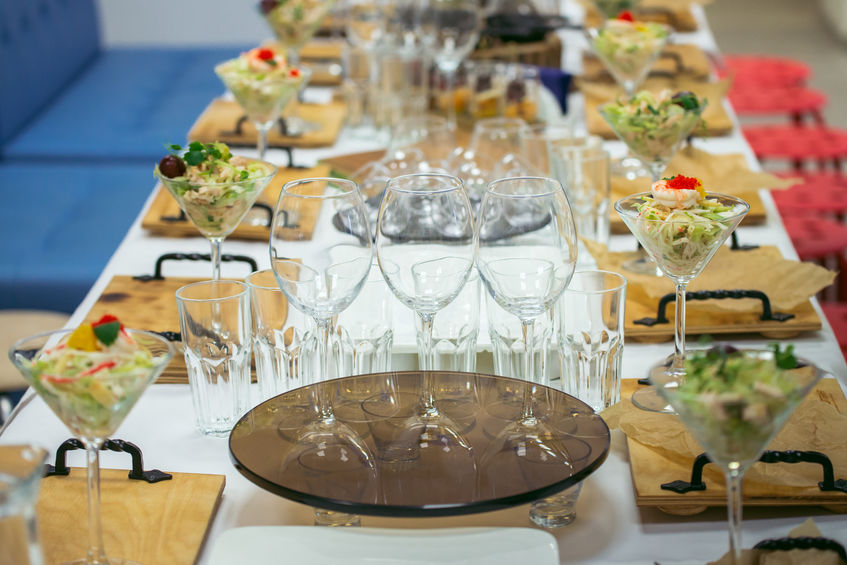 Banquet service is a more elaborate meal than a regular family dinner because of the number of guests present, the location, and the scope of the event. The word banquet means a sumptuous feast and is arranged to cater to a large number of people. There are many reasons for holding a banquet as it could be in honor of a visiting guest, anniversaries, birthdays, weddings, and other types of celebrations that bring people together. Today, banquets are implemented for events such as training sessions and formal business dinners, as they strengthen bonds between businesspersons and their partners. This article looks at different types of banquet services and their benefits.
Banquet service is a more elaborate meal than a regular family dinner because of the number of guests present, the location, and the scope of the event. The word banquet means a sumptuous feast and is arranged to cater to a large number of people. There are many reasons for holding a banquet as it could be in honor of a visiting guest, anniversaries, birthdays, weddings, and other types of celebrations that bring people together. Today, banquets are implemented for events such as training sessions and formal business dinners, as they strengthen bonds between businesspersons and their partners. This article looks at different types of banquet services and their benefits.
- Sit-Down Banquets
Sit-down banquets have their food served directly to guests while they remain seated on their tables. They are often more elegant and formal compared to other types of banquets since guests do not have to serve food by themselves. One of the benefits of organizing a sit-down banquet for your event is that guests feel more special since they do not have to line up on long queues to get food. Besides, there is more accuracy in terms of forecasting and food portioning. However, it requires a skilled staff familiar with the proper preparation and service sequence. Keep in mind that sit-down banquets are more time-consuming because of pre-plating. It can also be challenging to serve pre-cooked food at the right temperature depending on the event schedule.
- Buffets
A buffet is a type of banquet where guests are allowed to serve food by themselves. The food is served from various dishes that are displayed on a sideboard or long tables. Buffets are always less formal than sit-down meals making them ideal for birthday parties, training conferences and other special events that have a large number of guests. In terms of plating and serving, it is easier to prepare a buffet than a sit-down banquet because of the little number of staff required. All you have to do is select the items to be served and have an estimate of the number of guests who will be present.
- Passed-Tray Service
Passed-tray service is a type of banquet where the waiting staff circulates finger foods through the banquet room on large platters. A full meal may not be offered since the service operates continuously for a certain time. The total cost of organizing a passed-tray banquet may vary depending on the types of foods selected as well as the duration you wish the service to continue. One of the benefits of a passed-tray service is that it encourages conversations among guests as they get to know each other during this time. However, guests who expect to eat a full-course meal may not be satisfied if only passed-trays are offered.
- Station Service
A station service is a more advanced form of a buffet and the costs of organizing this type of banquet typically ranges somewhere between the price of a sit-down meal and a buffet. It involves setting up small tables around the banquet room and each station is packed with a different kind of food. A banquet server is given the task of replenishing food at various stations and can be the one to prepare and serve the food. Unlike other types of banquets, station service allows guests to mingle with other attendees as they move about the room. The stations may require minimal planning and guests can always return to enjoy their meal during a scheduled hour for having a snack or dinner.
- Pre-Set Service
A pre-set service is a type of banquet where food is set on the dining tables before guests are seated. It is commonly seen with items such as beverages, salads, desserts, and bread rolls. Desserts and salad will be pre-set for events with a limited period during lunch breaks. The food is usually kept sanitary at a good temperature, as it will be on the table for a few minutes before the guests arrive. However, maintaining the temperature of food especially when offering main entrees at a pre-set service may be a challenge as it depends on the method used to preserve the food.
Planning a banquet involves making decisions about the type of food, sitting arrangement, and how your guests will receive their food. Keep in mind that each type of banquet comes with its benefits and considerations. It is important to choose wisely and plan ahead of time to avoid disappointing your guests during the event.
